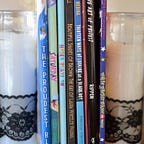Learning to respond to art, with The Poet X, by Elizabeth Acevedo
—Delia LaJeunesse
There were so many lovely components to the YA book, The Poet X. From the gentle tugging on, and expansion of, a sense of identity, to the dynamic relationships Xiomara, our protagonist, holds complexity for. Above all however, there was this one, very small section that really gave me pause.
I spend a lot of time thinking about what it would be like if we culturally were able to center the arts a little bit more, if we were all a little more literate in the arts. I ask a lot of questions, trying to understand why it is that we shy away from arts appreciation. Something I hear often is that there is a pressure people feel to say something eloquent or intellectual as a response to art.
Arts appreciation has always been a type of meditation for me. It is a meditation in that it causes me to slow down, to tune into my somatic processing, to become attentive and present. And in fact I think this experiential response to art is much more powerful and healing than any kind of intellectual or academic response. Acevedo articulates this power which art can have, in an interaction where Xiomara listens to her friend Isabelle read a poem, and then responds in this way:
“I put my apple down to focus,
because this feels like an important moment.
When she’s done, she doesn’t look at me.
And Isabelle isn’t the type not to look at someone.
I don’t tell her it’s good, even though it is.
I don’t tell her it’s beautiful, although it’s that, too.
“That gave me chills,” I say.
“I felt it here,” I say.
“You should finish it,” I say.
What we experience, where we experience it within our bodies, is so much more information than we think. Responding to a piece of art by articulating our somatic experience is powerful. This often makes a much larger impact than trying to sound intellectual, which is often a stale and regurgitated interpretation of art, or worse, offering up an art history lesson laden with jargon.
How simple, how accessible to take your body’s response to art and trust it.
I love how intimately Xiomara knows how to do this… how to articulate her feelings as she listened. She knows that saying “that was good”, or “that was beautiful” is insufficient. That it’s vapid. She knows that being able to articulate experience holds much more water than offering up a compliment.
The body is genuine.
The most valuable information we can get as artists is what the experience was like for the viewer as they took the work in, whether positive or negative. The ability to articulate how your body responded to a piece of art, where you felt it, is a truly beautiful and impactful articulation for the artist. And for you as the recipient of the art as well. It teaches you something about the translation of visual art, language, and movement, into emotion and somatic processing.
I am a very slow processor. If I have the permission to state what happened in my body, as opposed to summarizing a poem, or offering a well-constructed critique, or philosophizing on theme, I am in a much more receptive, playful and tender space to take in art. I hope that as the reader, the audience, the art goer, you too feel this permission to focus solely on the experience you had while taking art in.
This practice can be a beautiful meditation.
